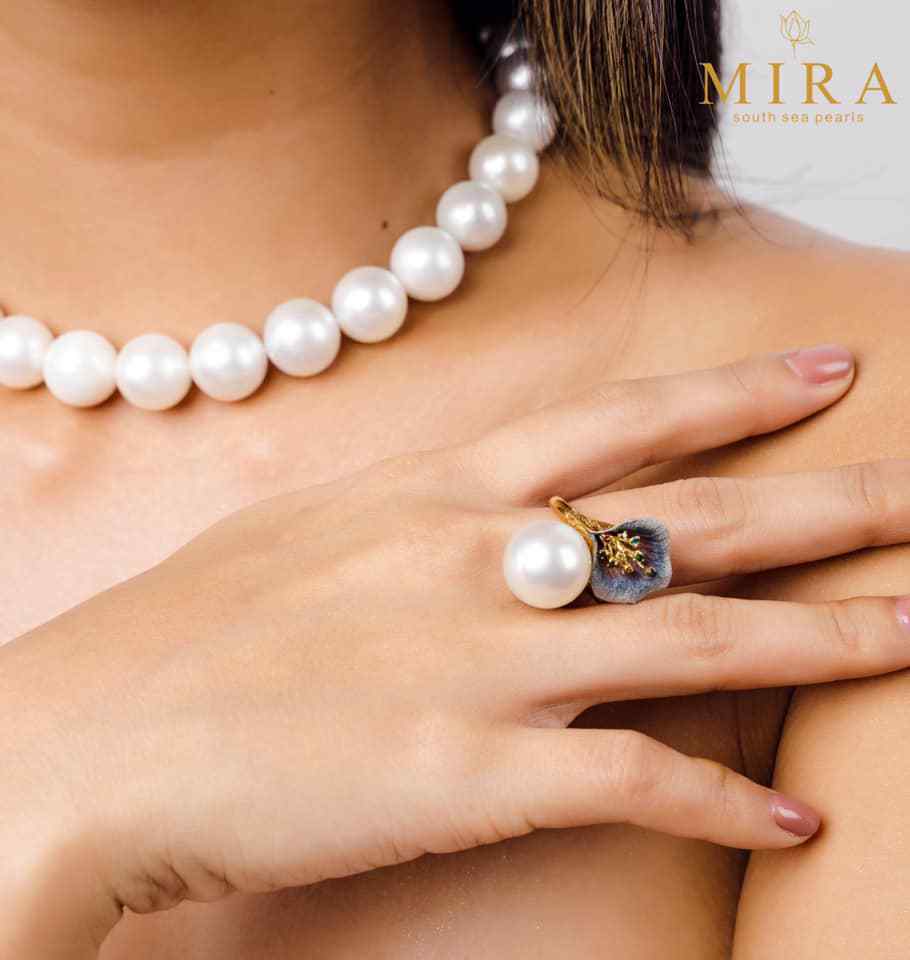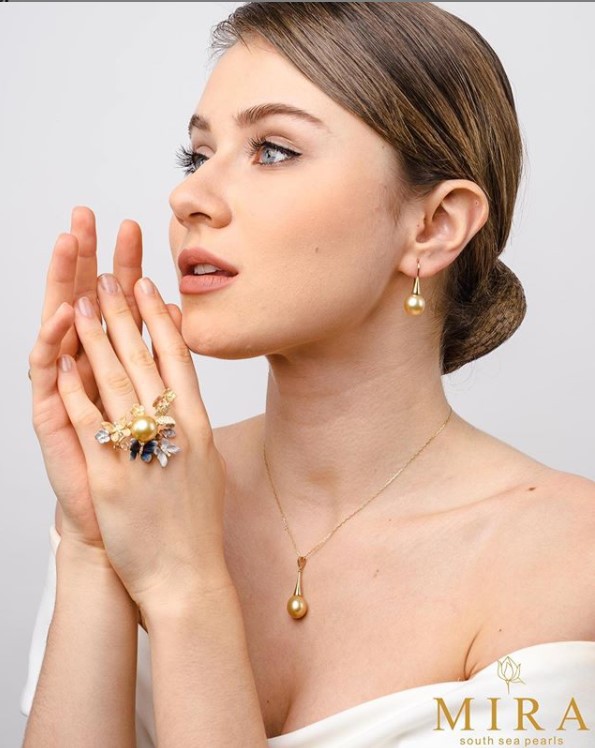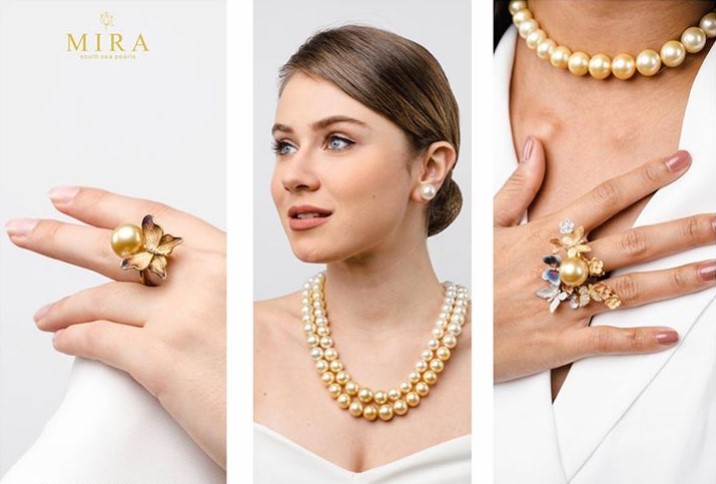When jewellery becomes pearls of wisdom

If one wants to talk about Indonesia’s most hidden gems, we cannot help but mention its South Sea pearls. Being one of the most precious cultured pearls in the world, they are true wonders of preciousness, materials that attract the eye and the heart.
There is a whole culture of pearl farming in the eastern part of Indonesia, with no one understanding the nature of pearls better than the region’s natives. One of these pearl connoisseurs is none other than Samira Aljufrie, the jewellery designer and founder of MIRA South Sea pearls.

The entrepreneur has always been interested in fine art jewellery and pearl farming, and has vowed to maintain a sustainable partnership with local pearl farmers across Indonesia.
Aljufrie sat down with DNE Buzz to outline what inspires her creativity, and why these pearls are such wonders to behold.
How did you start your journey in jewellery design?
My journey is quite unique, because I grew up in the pearl business. When I was young, my mother had a pearl business in collaboration with friends and family. I grew up on an island called Lombok in Indonesia’s Nusa Tenggara province.
When I decided to set up my own business, I named my brand Mira which is the last half of my name. Mira means “ocean” in Sanskrit, so I feel it’s my destiny to become a pearl jewellery designer.
The story began after I finished a study exchange programme in Germany. When I was 18 years old, I contacted one of my mum’s relatives and brought him a sample of two pearl pieces. I then went to the Hong Kong Jewellery and Gem Fair, where I showed the sample. Some dealers started ordering from me, which led to the birth of my brand. It also meant that, following my return to Indonesia, I could contribute to my country. As a result, I decided to set up a sustainable partnership with a series of local farms across Indonesia.

When did your brand start taking off?
When I held an exhibition in Jakarta, all my clients were asking whether I only do wholesale products or whether I do just the classic trends. They were also asking me if I can make them custom orders, such as rings and sets. This also saw me take on work creating unique designs that they could wear at parties.
As a result of this, I began to realise the importance of having collections, particularly among retail clients, as until then I had only really focused on wholesale. This meant that, previously, I had turned more to the wholesale markets in Hong Kong, Australia or Europe. The exhibition in Jakarta made me realise that there’s also a market closer to home, in my own country, so I started creating my own designs.
On the back of word-of-mouth recommendations by clients, I started to do a lot of exhibitions in Indonesia, Asia and Europe. And because I started to travel widely, this inspired my collections allowing me to pour my love of travel into my designs. I love my collections, because it has meaning and a story behind it.
What certificates have you obtained?
I attended a short course at the L’École Van Cleef & Arpels in Paris. I am autodidactic, and because of this, because I am naturally gifted and have this ability to create unique designs, I tend to create “One piece” collections. This means that my designs are very limited, and you only get one of each of them. Every collection has its own story behind the source matches. It is also important to realise that jewellery is a piece of art, with each piece having a story with a journey and meaning to it.
Why did you turn to creating jewellery from pearls?
As I mentioned, I was born and raised in a pearl farming family, and my mum was a jeweller also working in the pearl business. However, her business was small, because she only created jewellery for her relatives, she didn’t really do it as a proper business.
For me, however, I grew up in the pearl business, it is something I was born and raised in. Indonesia is also one of the biggest producers of South Sea pearls from the Pinctada Maxima oysters. It’s one of the biggest oysters you can find for cultured pearl these days, as well as the most valuable, so it’s considered a precious gemstone. It is also the only living gemstone on earth. This makes these pearls very unique.
What challenges did you face when you first started out?
As I am sure you know, starting your own business is not as easy as you think or see. Everything now may be settled and comfortable, but at the start I set out at just 18 years of age with just two pearl pieces.
I was also very young and naïve, which meant so many people tried to trick me. Another thing about business is that, if you have a good heart, you will find the way. So although I faced many struggles in starting up my business, mainly because it was so difficult establishing trust, I learnt so much about survival.

The fact that my father passed away when I was 8 years old also taught me a lot about survival. Since I was young, I have always had this survival mode. I learnt quickly that there’s always going to be a challenge in anything you do in life, especially when you start your own business. This is why it’s important to remember that you have to have courage in yourself, and to understand that you have to have a vision and mission. This helps you see that whatever you do, you have to do it in your own self-interests, and that your actions are the right thing to do.
What is the difference between natural and cultured pearls?
There is such a big difference between natural pearls and cultured pearls! The natural pearls are the finest ones to use, and occur when a grain of sand creates an irritant in pearl shells. With cultured pearls, however, you essentially help the oysters produce more of the secretions that eventually make the pearls, so of course the natural pearls is more valuable than cultured pearls.
South Sea pearls are the most expensive cultured product that can be found today, as it is such a complex process from hatchery to harvest. It can take up to four years a single pearl to grow into the type that can be used. This is why the value of South Sea pearls is so high – sometimes they are more expensive than gold!
If you compare natural pearls on the South Sea, you can count them by momme, particularly when dealing with large amounts of small pearls, and in grams. In Japan, the “momme”, which is usually used there, is equivalent to 3.75 grams, whilst in Indonesia, we tend to use grams.
For natural pearls, you can also use carats, as in the natural process there is really no help from humans.
Even with cultured pearls, however, there is an element of natural selection as out of every 1 million oysters, for instance, maybe only 1% will survive. When you want to start the process of hatching a pearl, you need to put a grain of sand in the shell, which will trigger the production of the liquid needed to make the layers of the pearl.
How are pearls assessed?
Each pearl is totally different, just like a diamond which has its own unique colour, clarity, and cuts. But whereas in the mining process you can make this selection for diamonds, pearls are a lot more natural and unreliable, you can’t predict the final pearl. This means that whatever comes out of the shell, it is natural, and you can’t cut or polish pearls either, as you might do with a pearl.

There are five factors that you can use to value Pearls, namely the shape, the quality, the size, the lustre, and finally the colour. You could add a sixth factor which is the overall complexion, made up of all of the five factors I just mentioned. Each of these factors have a different value to each person depending on their own likes.
It’s like the fingerprint of each pearl is different. In the wholesale part of the pearl business, we are really strict, and the grading system we always use is very good.
Do you work on your own or do you have assistants?
Before the novel coronavirus (COVID-19) pandemic, I had 10 shops as well as collaborations with department stores in Jakarta, including Galeries Lafayette. We even had one big branch in central Jakarta, alongside 17 staff in total. Since the pandemic started, however, we have gone down to just one store available, as all department stores and even my main shop have been closed. As a result, we decided to shift everything online, and only four staff members are now working with us out of 17.
What international exhibitions have you participated in?
I have participated in a range of exhibitions from New York to Hong Kong, Malaysia, Singapore, Jakarta , Japan, Kuwait, Italy, Spain, France.
Tell us about your design style. What makes your collections unique?
Since I started, my collection has been about a journey, my experiences from travelling around the world. I also love the mixture of people, culture and heritage, buildings and beauty, so it’s all about my inspirations, my own journey of experience and self-discovery, and how I put that into the jewellery I create.
What makes each piece unique is that it reflects my story, what I see, and what I feel. I put them into what I create, even seeing something beautiful, I put that too into jewellery. Wherever I go, I always make something that reminds me of my trip, the people I’ve met, the culture I saw, as well as the language they speak, the food, the architecture and so on. So everything is about my journey, with all its different and unique aspects.
How can we better educate the youth on craftsmanship and pushing their brands forward?
It’s about education! We can also share experiences, and push forward on sustainable relationships, like I carry out now with each pearl farmer I work with across Indonesia. We always ensure that we give back to the communities with whom we work, by providing support and medical help, when needed, as well as educating them about new technological developments, particularly in the jewellery business.

We also always aim to let them know that there is potential and opportunity if they want to work, that they can always achieve the best if they work for it.
What is your most favourite jewellery creation and why?
I really love “Le peregrina”, which is a natural pearl that belonged to US actress Elizabeth Taylor. It weighs about 55.6 carats, and is one of the biggest ever found. It’s such a masterpiece, but at the same time such a mystery. I love how they designed it at the time, because it is so beautifully done that I can’t find the words to explain it.
How many collections have you created so far?
I have created more than 300 items for collections, all of which have a different design inspired by my journey around the world, my culture, as well as the Indonesian heritage. I crafted these with the help of our talented local artisans on the island of Bali. My main goal is to promote my country’s cultures through my jewellery, as each piece has a different pattern of Balinese culture. My next collection is going to be an equestrian inspired one, taking inspiration from horse riding.
Have you ever been to Egypt? Do you know any jewellery designers in Egypt? What do you think of the Egyptian jewellery market?
I have never been to Egypt, but of course that’s one of my dreams! Of the jewellery designers in Egypt, I know Mema El Shafey. I really love her designs, because they are so inspired, with so much detail from nature, just like mine. Her designs are really ballsy and courageous, but still inspired by Nature.
About the Egypt jewellery market, I think it is very interesting to get to know this market because Egypt has a long history with jewellery. I would love to do any collaboration with a jewellery designer, and I am looking forward to finding a partner or wholesaler with whom I can collaborate with and launch my own collection in the country. Although South Sea pearls are produced in Saudi Arabia, the Philippines and Australia, Indonesia produces 80% of the world market. We also produce champagne golden pearls, as well as white and silver South Sea pearls. Because of the variety in Indonesia, I would love to do a collaboration or start designing Egyptian inspired items that will enter the market there.
What is your plan for the coming period?
It is to keep sustainable partnership with my local pearl farmers across in Indonesia and to maintain you know mutualisms fair trade business between pearl farmers, and South Sea pearls former, across Indonesia and also to switch all of my jewellery into appointment or online purchases website, which now we are already doing. and you can purchase in our website www.mirasouthseapearls.com and also, I’m going to launch a new collection about equestrian “Equestre collection “ and we will have five influencer horse like a mostly a public figure that we going to equestrian about horses that’s what I do now because I play polo and for the future I would like to keep sustainable partnership between my peal farmers in us and create more communication of a collection for export of course no reality export my loose pearls and also some of our jewellery wholesale so we would like to expand the market and we would like to enter a new opportunity in Egyptian jewellery market .
What advice do you give clients when they buy pearls?
First of all, you have to know how to look for quality, and I mean good quality pearls. These should be seen as investments, because each pearl is different so they are like fingerprints. The better quality of, and also more expensive, South Sea pearl entails you are looking at 15mm in size or above. However, I would also recommend that you look at what suits you best.
What advice would you give young designers?
I would advise young designers that you have to keep trying, stay experimental, and never listen to what people say. You should also always listen to your heart, keep your imagination open as wide as possible, as the sky really has no limit. This latter point is why you should keep trying, by putting all your creative ideas into each beautiful piece of jewellery that you create.
You have your own taste, which will help you put your own identity and character on each item of jewellery. This will help you stand tall against the sometimes stiff competition in this sector, because nowadays so many jewellery designers have to be unique. Always keep sight of your own vision and imagination, so that you can put it into a very beautiful and unique piece of jewellery.
Another important lesson is, if you don’t succeed, then never ever lose hope of trying again and trying in a different way. Altering and adapting will help you create your own unique style and character that will help create an identity for your designs, so that you stand out against other designers that are available today.















